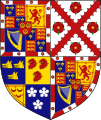Bastard coat of arms


The Bastard Coat served in the Middle Ages in the heraldry of labeling illegitimate sons of a nobleman , that an illegitimate birth.
meaning
Since, especially in the case of sovereign princes such as kings or emperors, the father was by no means obliged to publicly recognize his illegitimate descendants, the award of a bastard coat of arms was usually rather a rarity and was very often associated with the award of a title of nobility and a place of residence in accordance with one's status.
In the perception of the rest of the non-sovereign nobility, being a recognized descendant of the reigning prince generally did not constitute a reason for social disdain, but on the contrary offered the non-sovereign nobility the opportunity to have connubium with the social environment of the reigning prince , even if a marriage into the actual ruling dynasty was socially unthinkable due to the social class difference.
Geographical differences
In southern and southeastern Europe, a bastard thread (oblique left thread ) was placed over the father's coat of arms . That is a motto . It runs from top left to bottom right (heraldic: from the point of view of the wearer) over the entire shield. A short “ piece of bar ” is referred to as an oblique left-hand slump . For a legitimate birth, the direction of the sign is upside-down and right-angled.
In northern and northwestern Europe, the paternal coat of arms usually appeared in the upper right corner (upper or front square) of the otherwise unmarried shield.
Examples
Wittelsbacher bastard coat of arms
Family coat of arms of Count Holnstein
Epitaph of Caroline Josepha von Holnstein geb. von Bretzenheim (1768–1786) with the family coats of arms Holnstein (left) and Bretzenheim (right)
English bastard coat of arms
Family coat of arms of the Dukes of Grafton
Family coat of arms of the Dukes of St. Albans
Family crests of the Dukes of Buccleuch and Queensberry
Family Crest of the Dukes of Richmond
Family coat of arms of the Dukes of Beaufort
See also
literature
- Walter Leonhard: The great book of heraldic art. Development, elements, motifs, design. License issue. Bechtermünz, Augsburg 2001, ISBN 3-8289-0768-7 , p. 345.






